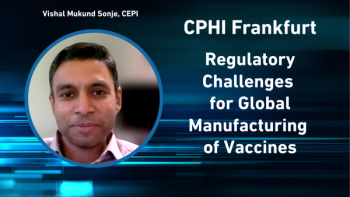
- Pharmaceutical Technology-10-02-2019
- Volume 43
- Issue 10
Getting in Touch with New Guidance on Topical Products
Changing regulatory guidance on generic topical products is expected to lead to an increase in the number of market approvals in the near future.
Editor’s Note: This article was published in Pharmaceutical Technology Europe’s October 2019 print issue.
The regulatory landscape governing the approval of generic topical products has been changing significantly in Europe and the United States recently. This is creating new opportunities for generic companies to expand their product ranges in the treatments for the skin, eye, nails, and mucosal membranes.
Historically, the barriers facing companies that have wanted to introduce generic topical products have been sufficiently high to dissuade companies from investing in the product development required. These barriers to investment are now being recognized by governments and payers, and steps are being taken to encourage more topical generic product development.
The use of branded products where generic options are available increases patient expense by an estimated $1.2 billion (€1.1 billion) in the US (1), and similar practices in the United Kingdom are costing the National Health Service £200 million (€227 million) annually (2).
Therapeutic bioequivalence: A major barrier
A major barrier to cost-effective development of topical products has been the historical requirement for clinical trials to demonstrate therapeutic bioequivalence with the reference product. The costs, typically in the millions of Euros, and substantial risks associated with these trials are untenable for many generic topical drug developments because the products often occupy niche markets. These hurdles to development are exacerbated in Europe where the market is split between the member states and ultimately any product needs to be registered in each market.
As with any product development, generic-drug companies need to be confident that they can expect their product to deliver sufficient return on investment. Consequently, many topical products have continued on the market unchallenged by new generic products because of the prohibitive nature of the previously mentioned costs, and risks from any clinical trial.
Regulatory action
So, what are the actions that have been taken by regulators? A few years ago, the Medicines and Healthcare products Regulatory Agency (MHRA) based in the UK, alongside the European Medicines Agency (EMA), made the first step towards changing the regulatory landscape for generic products. They approved at least two topical applications for generic products, one for dermatology and one for nails and accepted that no clinical bioequivalence data was required (3,4). In both of these submissions, the content and physiochemical properties of new topical formulations were exactly matched to those of the originator product. Data had to be presented to demonstrate that the generic and the originator product both had the same critical excipients in the same concentrations and that the physical microstructure of the two formulations was the same. The bioequivalence was effectively demonstrated using in-vitrorelease testing (IVRT) and in-vitropermeation testing (IVPT) performance models. In-vitro disease activity models were also submitted to support the successful submissions where data were collected using ex-vivohuman nails and skin. One of these submissions was in relation to a product that contained a steroid as an active ingredient, and the data presented also included an in-vivoskin blanching/vasoconstrictor assay study in healthy volunteers.
IVRT measures the release of a drug out of a semi-solid formulation and through a membrane specifically selected not to impede that release. This type of performance testing is analogous to testing the dissolution testing of tablets. Regulatory bodies are increasingly expecting IVRT to be used as a quality tool and as part of all semi-solid release and stability specifications. Traditionally run in vertical diffusion (‘Franz’) cells, this testing is now being automated to improve throughput and reproducibility.
IVPT measures the penetration into and permeation across human skin. IVPT is immeasurably more complex than IVRT because of the variability with skin from the same donor as well as donor-to-donor variability.
Disease activity models measure the activity of a drug on a disease-related pathway or an induced infection to establish whether the drug is bioavailable, engages the target, and can act on the desired pathway. In tandem with penetration and permeation testing, these sophisticated models provide the closest analogy to the clinic.
EMA published draft guidelines to be used for the development of generic topical pharmaceuticals at the end of 2018 (5). This draft followed a three-year period where comments on their concept paper, published in 2015 (6), were submitted and reviewed. EMA’s guidance utilizes IVRT and IVPT and covers the full range of generic topical products including indications for the eye, nose, and nail, as well as dermal applications. EMA has been collecting feedback from interested parties over the past six months and can be expected to provide an update of the guidance in the coming future, although no timetable has been published.
In contrast, the US Food and Drug Administration (FDA) has issued specific guidance documents for several topical products (7). The requirements of FDA and EMA are broadly similar, although there are subtle differences, for example in the statistical treatment of some data. The majority of FDA’s draft guidance references back to its draft guidance on acyclovir cream published in 2017 (8). This was the first FDA guidance to offer an in-vitroonly route for demonstrating bioequivalence.
Relatively complex models
To the untrained eye, these performance testing models may seem to be straightforward lab experiments. They are, in fact, relatively complex with many variables, which can have a significant impact on results. Chilcott et al.showed that up to a 30% variation can occur between laboratories using the same IVRT protocol, the simplest of the models (9). Unsurprisingly, regulatory bodies expect a high standard of validation on such bioequivalence tests and in addition to this, the studies must be performed under rigorous levels of quality assurance oversight. As expected from Chilcott et al.’s findings, the levels of variability produced can challenge the limits of these methodologies. There have been reports of some laboratories that have tried to develop suitable IVRT and IVPT methods but have been unable to reach the guidance’s thresholds due to a lack of experience. It is important for developers to understand the experimental rigour needed, and have the required experience to generate acceptable data packages. In combination with expertise in the field, the multiple steps and time needed to establish an acceptable level of validation under the appropriate quality standards inevitably means that the costs involved are not insignificant, are typically more than for tablets. Critically they remain much less than the cost of having to do a clinical trial to generate the same bioequivalence data.
IVPT is particularly challenging. Expertise is required to truly understand how to minimize the inherent variation wherever possible. As drugs increase in size and lipophilicity the levels permeating through the skin can quickly approach the analytical detection limits of even modern liquid chromatography–mass spectrometry equipment. To add to these challenges associated with minimizing data variation, the guidance documents also require that any analytical methods be fully validated, which, experts in the field know, is no easy task. It is also clear even with the utmost care and careful experimentation, getting the data required as written in some product guidance documents can still be a challenge and needs to be a central part of any discussion with regulatory authorities.
Highly knowledgeable partners, with experience in supporting generic clients to manage these challenges, understand how to use in-vitromethods as a lowerâcost route to demonstrating bioequivalence. Regulators and developers are now starting to appreciate the sensitivity of data from IVRT above those from IVPT when identifying any subtle difference between a new topical generic formulation and the originator product. Experienced practitioners understand that the variability in IVPT data can be mitigated by using fresh tissue and careful handling in particular within single donor samples.
New opportunities
So, while the generics industry is waking up to the new opportunities, they are also learning that the development of topical generic formulations typically requires more specific expertise than oral solid dosage forms due to their more complex nature. There is an increased understanding that the significant investment required is still smaller than trying to demonstrate bioequivalence in the clinic.
Regulators on both sides of the Atlantic, in Europe, and the US, have clearly expressed willingness to provide more clarification to developers as to what is expected in generic submissions; a consequence of the scarcity of generic submissions historically. EMA is continuing to provide developers with product-specific guidance on the suitability of their methodologies and protocols in pre-booked structured scientific advice meetings. Historically, when the applicant provides initial data using the approach they plan to take, these meetings have proved invaluable in providing clear advice on what will be acceptable to an authority. The meetings in particular help clarify areas of uncertainty in the new guidance documents. Similarly, FDA is now open to pre-ANDA (abbreviated new drug application) meetings to discuss specific submissions.
In the latest guidance, EMA has extended the applicability of the in-vitro approach from dermal indications to include those for the eye, nail, and nose, and other sites of local delivery (5). Recently, FDA has also announced the introduction of research grants to encourage development beyond skin to other epithelial tissues (10).
The cumulative effects of these changes can be expected to increase the number of market-approved generic topical products in the coming years as desired by the regulatory authorities. Both early adopters and patients can expect to benefit from this new approach to generic product regulations, as more companies take the opportunity to broaden their footprint in topical product development.
References
1. R.J. Desai, et al., BMJ 361 (k1180) 3 April 2018.
2. National Audit Office, “Prescribing Costs in Primary Care,” nao.org.uk, 18 May 2007.
3. MHRA, “Public Assessment Report: Decentralized Procedure-Xemacort 20 mg/g + 1 mg/g Cream (Fusidic Acid and Betamethasone Valerate),” mhra.gov.uk, January 2016.
4. MHRA, “Public Assessment Report: Decentralized Procedure-Amorolfine 5% W/V Nail Lacquer, Amorolfine 5% W/V Medicated Nail Lacquer, Amorolfine Hydrochloride 5% W/V Medicated Nail Lacquer, Tinecur 5% W/V Medicated Nail Lacquer, Amorstad 5% W/V Medicated Nail Lacquer,” mhra.gov.uk, 20 July 2011.
5. EMA, Draft Guideline on Quality and Equivalence of Topical Products, ema.europa.eu, 18 Oct. 2018.
6. EMA, “Concept Paper on the Development of a Guideline on Quality and Equivalence of Topical Products,” ema.europa.eu, 2 Dec. 2014.
7. FDA, “Product-Specific Guidances for Generic Drug Development,” PSG Database, accessdata.fda.gov [accessed 24 Sep. 2019].
8. FDA, Draft Guidance on Acyclovir, accessdata.fda.gov, Revised Dec. 2016.
9. R. Chilcott, et al., J. Pharm. Sci. 94 (3) 632–638 (2005).
10. FDA, “
Article Details
Pharmaceutical Technology Europe
Vol. 31, No. 10
October 2019
Pages: 62–64
Citation
When referring to this article, please cite it as J. Drummond, “Getting in Touch with New Guidance on Topical Products,” Pharmaceutical Technology Europe 31 (10) 2019.
Articles in this issue
about 6 years ago
FT-IR Spectrometerabout 6 years ago
Nexera Prep Seriesabout 6 years ago
Pharmaceutical Cleanroom Monitoringabout 6 years ago
Multi-Shaft Mixers for High-Quality Gels and Creamsabout 6 years ago
Stability Testing for Small-Molecule Clinical Trial Materialsabout 6 years ago
Image Repair Must Get to the Root Causeabout 6 years ago
The Never-Ending Brexit?about 6 years ago
Out with the Old and In with the New European Commissionabout 6 years ago
Data Integrity Violations Draw Strong FDA Rebukesabout 6 years ago
The Fundamentals of Dissolution TestingNewsletter
Get the essential updates shaping the future of pharma manufacturing and compliance—subscribe today to Pharmaceutical Technology and never miss a breakthrough.





